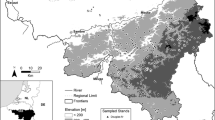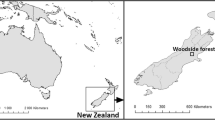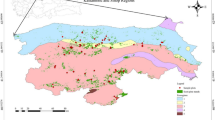Abstract
Studies show that homogeneity among trees interferes with stand productivity, however, this information has not been incorporated into stand-level growth and yield models to assist forest managers. This paper presents a new format for basal area growth modeling, that includes the effect of homogeneity on stand productivity and was developed for unthinned and thinned Pinus taeda stands. The database came from a 3 × 3 factorial experiment with the factors of initial density (2500, 1250, and 625 trees ha−1), and thinning (without thinning, moderate thinning, and heavy thinning). The diameter distribution represented by the percentile method was used to represent stand homogeneity. The diameters (located in the 10th and 63rd percentiles) were inserted into the basal area growth model, which greatly increased the precision of the estimated predictions and projections. A simultaneous basal area growth model, compatible in prediction and projection, with the inclusion of stand homogeneity, is recommended for estimating the basal area growth of Pinus taeda stands in southern Brazil.








Similar content being viewed by others
References
Alvares CA, Stape JL, Sentelhas PC, Gonçalves JLM, Sparovek G (2013) Köppen’s climate classification map for Brazil. Meteorol Zeitschrift 22:711–728. https://doi.org/10.1127/0941-2948/2013/0507
Assmann E (1970) The principles of forest yield study. Pergamon Press, Oxford
Binkley D, Senock R, Bird S, Cole TG (2003) Twenty years of stand development in pure and mixed stands of Eucalyptus saligna and nitrogen-fixing Facaltaria moluccana. For Ecol Manag 182(1–3):93–102. https://doi.org/10.1016/S0378-1127(03)00028-8
Burkhart HE, Tomé M (2012) Modeling forest trees and stands. Springer, New York
Campoe OC, Stape JL, Nouvellon Y, Laclau JP, Bauerle WL, Binkley D, Le Maire G (2013) Stem production, light absorption and light use efficiency between dominant and non-dominant trees of Eucalyptus grandis across a productivity gradient in Brazil. For Ecol Manag 288:14–20. https://doi.org/10.1016/j.foreco.2012.07.035
David HC, Péllico Netto S, Arce JE, Woycikievicz APF, Araújo EJG, Miranda ROV (2018) Intensive management for optimizing the production of high-value logs of pine forests in southern Brazil. Ci Fl 28(3):1303–1316. https://doi.org/10.5902/1980509833352
Dobner Jr M (2013) Crown thinning effects on growth and wood quality of Pinus taeda stands in southern Brazil. Ph.d Thesis, Albert-Ludwigs-Universität
Dobner Jr M (2015) Desbaste pelo alto: uma alternativa rentável para povoamentos de Pinus taeda no Sul do Brasil. Santa Catarina State, Brazil. https://engenhariaflorestal.paginas.ufsc.br/files/2015/09/Cartilha_desbaste_Dobner-e-Huss.pdf Acessed 25 Apr 2022
Dobner M Jr, Quadros DS (2019) Economic performance of loblolly pine stands in southern Brazil as a result of different crown thinning intensities. Rev Árvore 43(2):1–11. https://doi.org/10.1590/1806-90882019000200004
Efron B (1982) The jackknife, the bootstrap and other resampling plans. Society for Industrial and Applied Mathematics, Philadelphia
Embrapa (Empresa Brasileira de Pesquisa Agropecuária) (1988) Zoneamento ecológico para plantios florestais no estado de Santa Catarina. Curitiba, Brazil. https://ainfo.cnptia.embrapa.br/digital/bitstream/item/17024/1/doc21.pdf. Acessed 25 June 2022
Hakamada RE, Stape JL, de Lemos CCZ, Almeida AEA, Silva LF (2015) Uniformidade entre árvores durante uma rotação e sua relação com a produtividade em Eucalyptus clonais. Cerne 21(3):465–472. https://doi.org/10.1590/01047760201521031716
Hall KB, Stape JL, Bullock BP, Frederick D, Wright J, Scolforo HF, Cook R (2019) A growth and yield model for Eucalyptus benthamii in the Southeastern United States. For Sci 66(1):25–37. https://doi.org/10.1093/forsci/fxz061
IBÁ (Indústria Brasileira de Árvores) (2022) Annual report of IBÁ 2022, base year 2021. https://www.iba.org/datafiles/publicacoes/relatorios/relatorioiba2021-compactado.pdf Accessed 30 Nov 2022
Lam TY, Guan BT (2020) Modeling stand basal area growth of Cryptomeria japonica D. Don under different planting densities in Taiwan. J for Res 25(3):174–182. https://doi.org/10.1080/13416979.2020.1733171
McTague JP, Bailey RL (1987) Compatible basal area and diameter distribution models for thinned loblolly pine plantations in Santa Catarina. Brazil for Sci 33(1):43–51. https://doi.org/10.1093/forestscience/33.1.43
McTague JP, Patton DR (1989) Stand density index and its application in describing wildlife habitat. Wildl Soc Bull 17(1):58–62
McTague JP, O’Loughlin D, Roise JP, Robison DJ, Kellison RC (2008) The SOHARC model system for growth and yield of southern hardwoods. South J Appl for 32(4):173–183. https://doi.org/10.1093/sjaf/32.4.173
Montes CR (2012) A resource driven growth and yield model for loblolly pine plantations. Ph.d Dissertation, North Carolina State University
Oliveira LC (2012) Erosão hídrica e alguns processos hidrológicos em plantios de pinus, mata, campo nativo e estrada florestal. Ph.d Thesis Federal University of Santa Catarina
Peng C (2000) Growth and yield models for uneven-aged stands: past, present and future. For Ecol Manag 132:259–279. https://doi.org/10.1016/S0378-1127(99)00229-7
Pienaar LV, Shiver BD (1986) Basal area prediction and projection equations for pine plantations. For Sci 32(3):626–633. https://doi.org/10.1093/forestscience/32.3.626
R Core Team (2019) R: a language and environment for statistical computing. R Foundation for Statistical Computing, Vienna. http://www.R-project.org. Accessed 09 Nov 2020
Retslaff FAS, Figueiredo Filho A, Machado SA, Arce JE, Jaskiu E (2016) Diagrama de manejo da densidade para Pinus taeda no estado do Paraná. Floresta 46(2):185–195. https://doi.org/10.5380/rf.v46i2.38301
Ryan MG, Stape JL, Binkley D, Fonseca S, Loos RA, Takahashi EN, Silva CR, Silva SR, Hakamada RE, Ferreira JM, Lima AMN, Gava JL, Leite FP, Andrade HB, Alves JM, Silva GGC (2010) Factors controlling Eucalyptus productivity: how resource availability and stand structure alter production and carbon allocation. For Ecol Manag 259:1695–1703. https://doi.org/10.1016/j.foreco.2010.01.013
Santos GM, Oliveira XM, Homczinski I, Mayrinck RC, Cavassim WS (2021) Generalized mixed modeling to estimate tapering of Pinus taeda trees in different planting spacings. Adv for Sci 8(1):1261–1269. https://doi.org/10.34062/afs.v8i1.12414
Schneider PSP, Finger CAG, Schneider PR, Mendes JO (2018) Trajetória bioeconômica dos regimes de manejo em povoamentos de Pinus taeda L. Ci Flor 28(3):1104–1117. https://doi.org/10.5902/1980509833357
Scolforo HF, McTague JP, Raimundo MR, Weiskittel A, Carrero O, Scolforo JRS (2018) Comparison of taper functions applied to eucalypts of varying genetics in Brazil: application and evaluation of the penalized mixed spline approach. Can J for Res 1:cjfr-2017-0366. https://doi.org/10.1139/cjfr-2017-0366
Scolforo HF, McTague JP, Burkhart H, Roise J, Campoe OC, Stape JL (2019a) Eucalyptus growth and yield system: Linking individual-tree and stand-level growth models in clonal Eucalypt plantations in Brazil. For Ecol Manag 432:1–16. https://doi.org/10.1016/j.foreco.2018.08.045
Scolforo HF, McTague JP, Burkhart H, Roise J, McCarter J, Alvares CA, Stape JL (2019b) Stand-level growth and yield model system for clonal eucalypt plantations in Brazil that accounts for water availability. For Ecol Manag 448:22–33. https://doi.org/10.1016/j.foreco.2019.06.006
Sun H, Zhang J, Duan A, He C (2007) A review of stand basal area growth models. For Stud China 9(1):85–94. https://doi.org/10.1007/s11632-007-0014-2
Sun HG, Diao S, Liu R, Forrester D, Soares A, Saito D, Dong R, Jianga J (2018) Relationship between size inequality and stand productivity is modified by self-thinning, age, site and planting density in Sassafras tzumu plantations in central China. For Ecol Manag 422:199–206. https://doi.org/10.1016/j.foreco.2018.02.003
Trilleras AB, Aguirre AML (2020) Basal area growth models for Eucalyptus tereticornis Smith stands on the Colombian Atlantic coast. Madera y Bosques 26(2):e2621924. https://doi.org/10.21829/myb.2020.2621924
Vanclay JK (1994) Modelling forest growth and yield: applications to mixed tropical forests. CAB International, Wallingford
Weiskittel AR, Hann DW, Kershaw JA Jr, Vanclay JK (2011) Forest growth and yield modeling, 1st edn. Wiley, Oxford
Wickham H (2016) ggplot2: Elegant graphics for data analysis. Springer, New York. https://cran.r-project.org/web/packages/ggplot2/index.html. Accessed 10 Nov 2020
Xu Y, Goodacre R (2018) On splitting training and validation set: a comparative study of cross-validation, bootstrap and systematic sampling for estimating the generalization performance of supervised learning. J Anal Test 2(3):249–262. https://doi.org/10.1007/s41664-018-0068-2
Acknowledgements
The authors are especially grateful to the private enterprise Florestal Gateados, Forest Management Laboratory (LEMAF) ate Federal University of Lavras (UFLA) and Coordenação de Aperfeiçoamento de Pessoal de Nível Superior (CAPES).
Author information
Authors and Affiliations
Contributions
All authors contributed to the study conception and design. XO and HS Project Idea, Processing, Analysis, Writing, Review. JPM and JRS Analysis, Writing, Review. MDJr Database, Analysis, Review.
Corresponding author
Ethics declarations
Conflict of interest
The authors declare that they have no known competing financial interests or personal relationships that could have appeared to influence the work reported in this paper. The authors did not receive support from any organization for the submitted work.
Additional information
Publisher's Note
Springer Nature remains neutral with regard to jurisdictional claims in published maps and institutional affiliations.
Rights and permissions
Springer Nature or its licensor (e.g. a society or other partner) holds exclusive rights to this article under a publishing agreement with the author(s) or other rightsholder(s); author self-archiving of the accepted manuscript version of this article is solely governed by the terms of such publishing agreement and applicable law.
About this article
Cite this article
de Oliveira, X.M., Scolforo, H.F., McTague, J.P. et al. Modeling the effect of stand homogeneity on basal area growth for unthinned and thinned Pinus taeda L. stands in southern Brazil. New Forests (2024). https://doi.org/10.1007/s11056-024-10042-0
Received:
Accepted:
Published:
DOI: https://doi.org/10.1007/s11056-024-10042-0




